|
|
DIAGRAMS AND DEVICES
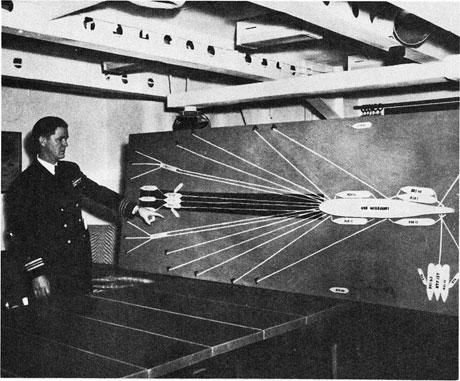

ENCLOSURE 10
|
1
|
|
DIAGRAMS AND DEVICES
1. A number of graphic records were devised and used in the refloating operation of the U. S. S. MISSOURI. It was evident early in the operation that a number of studies could be made graphically to corroborate or amplify engineering calculations. It was also desirable to transmute certain statistics to graph form for ready reference and more facile comprehension. Still other visual records were necessary for the charting and analysis of progress.
2. Specifically the graphic and visual records kept of the operation were as follows:
|
a. Space-time diagram: In realization of the tremendous importance of space along the ship's side for the many aspects of the salvage operation and to prevent conflicts in the schedule for utilization of the ship's side, a diagram was devised showing the planned hourly utilization of the entire side of the ship both port and starboard from 22 January until 2 February. The ship was drawn in plan view and the entire scheduled use of each side for the planned period of the operation was shown horizontally in units of time. For example if diving and tunneling operations were planned in the master schedule from 0700 to 1500 on 26 January on the port side at frame 107, a block representing in length the number of frames of the ship's side required for the salvage vessel itself and for diving operations and representing in width the number of hours scheduled was drawn on the space-time chart. The entire master schedule from 22 January to 2 February was outlined in this manner. Conflicts became immediately apparent and the schedule was adjusted accordingly. This diagram is included in the Narrative.
b. Weight-draft diagram: For ready reference and visual comprehension of the weight-draft relationship, a graph was designed showing in the horizontal component time and in the vertical component depth of water varying with the predicted tide. Also in the vertical component was a line representing the free floating draft of the ship at the time of grounding and the effect on this draft of removal of weights such as ammunition, fuel, etc. The point of intersection determined the condition of weight at which the vessel would float. The distance between the line representing draft and the one representing depth of water as affected by tide conditions at any time showed the inches of draft the ship lacked of floating and hence the weight that would have to be pulled off. Multiplying this weight by the coefficient of friction gave the tons of pull required at any time. This diagram is reproduced as appendix (A) to this enclosure.
c. Time-tide-ship movement graph: This graph indicated the movement of the ship with various conditions of tide. Horizontal components represented time. On this chart was plotted the predicted tidal movements over the period of 17 January to 2 February. Superimposed were actual tidal conditions recorded for each high and low as occurring and, from the 30th on, hourly tide conditions. Wind conditions for each tide were shown below the tide lines by means of arrows indicating direction and velocity. A study of this portion of the chart shows at a glance the predicted high tides over the salvage period, the actual tides as they occurred, and the relative effect of the wind on tides at the position of the MISSOURI.
Also placed on this same chart, above the tide studies, and correlated with time and tide were list and vertical movement lines. Cross-level readings were plotted hourly as were also readings of a gunner's quadrants placed athwartships. These readings showed visually any list movement to port or starboard under varying tide conditions or load conditions of the ship.
Two long metal tubes (70 feet long and 6 inches in diameter) were driven into the sand bottom at the bow and stern and so designed that a pointer on the ship read against a gauge on the tube indicated vertical movement of the ship in inches. Recording of hourly readings on the chart showed visually any vertical movement of the ship as tides varied and as the ship was lightened or ballasted.
Similar gauges located at frame 107 port and starboard showed both vertical movement of the ship at that point and also difference in movement between the two sides.
Two more lines plotted from hourly readings of gunner's quadrants placed fore and aft in the bow and stern corroborated the movement shown by the vertical movement gauges.
|
|
2
|
|
The time-tide-ship movement graph was extremely valuable in showing visually the movements of the ship as ammunition was off-loaded, fuel oil removed or added and as the tide changed. It also gave a good indication of the pivot point of the ship under various conditions as they occurred. The original graph showing level and cross-level readings, predicted and actual tides, actual drafts, wind conditions, vertical movement and list as shown by the four movement gauges and vertical movement as shown by the two gunner's quadrants is reproduced as appendix (B). Predicted and actual tides as reproduced by Norfolk Naval Shipyard are included as appendix (C). Vertical movement as shown by the movement gauges and as reconstructed by the Shipyard is included as appendix (D). Vertical movement portrayed by the gunner's quadrants as reconstructed by the Shipyard is shown as appendix (E).
d. Ships profile-soundings diagram: A large profile of the MISSOURI was prepared showing both port and starboard side. Soundings taken from about frame 100 aft at the ship's side, at a distance of ten feet, and at a distance of twenty feet were plotted on transparent acetate paper. Placed over the profile drawing, lines drawn from plotted soundings showed the draft at the ship's side and at 10 and 20 feet from the side. It was planned to keep current contour lines but the inability to take soundings because of use of the ship's side for diving, pontooning, etc., prevented this project from being fully exploited.
Somewhat similar drawings were also used in plan view to show the progress of tunneling operations. Filling in and silting and the difficulties experienced by divers in analyzing and reporting accurately their tunneling progress and actual underwater conditions as regards bottom contour under and around the hull prevented these charts from being as useful as had been hoped.
e. Pull-off plan models: A large sheet of plywood was used to represent the operating area. On this layout, plywood scale models of MISSOURI and all ships engaged in the salvage operations as well as lines and anchors representing beach gear were used to plan the pull-off operation. This same layout was used to show current ship's positions. The positions of dredges, salvage ships, etc., were shown in relation to the MISSOURI using the scale models and were changed as ship's positions changed in the operating area. Reproductions of this model layout with vessels shown in the pull-off plan position, as actually employed on 31 January and 1 February are included in the Narrative. It should be noted that the bow beach gear shown on the pull-off layout, since it was part of the plan, was cast free prior to the 31 January coordination rehearsal.
f. Wind Board: Current wind direction and velocity were shown by an arrow pivoting on a compass circle with wind velocity drawn in chalk and kept current.
g. Progress: Charts were used to show progress accomplished in the major tasks. Time already elapsed and days remaining until the target date also were prominently displayed. A visual record of the progress of each phase of the operation was charted and kept current, appendix (F). In addition progress summaries were prepared twice daily. These summaries have been incorporated in enclosure 13 and are not included as a part of this enclosure.
|
APPENDIX (A) - Tide Study and Weight Reduction Curves
APPENDIX (B) - Time-Tide-Ship Movement Graphs
APPENDIX (C) - Tide Study Curves
APPENDIX (D) - Vertical Movement of Vessel Prior to Refloating
APPENDIX (E) - Trim as Observed by Gunner's Quadrants Forward and Aft
APPENDIX (F) - Progress Chart
|
3
|
Page 3, Appendix A.
Tide Study and Weight Reduction Curves
(Large image is on separate page.)
|
4
|
|
This page is blank.
|
5
|
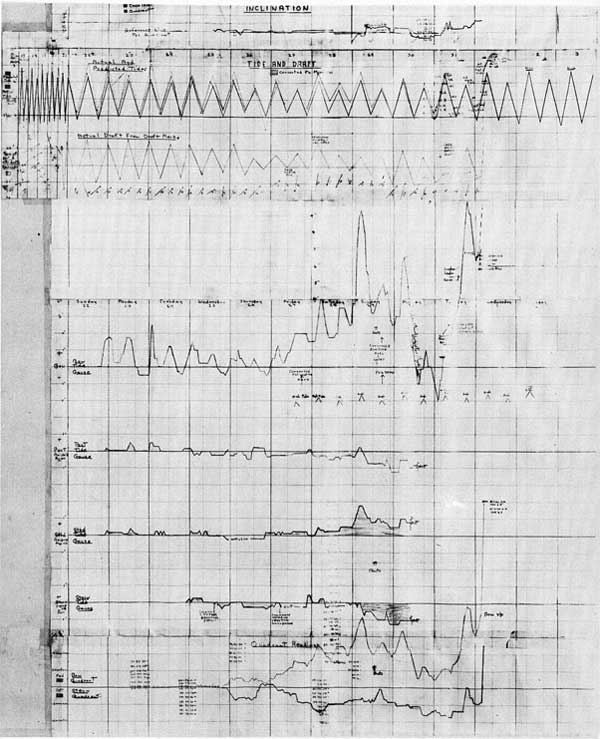
Time-Tide-Ship Movement Graphs
APPENDIX (B) TO ENCLOSURE 10
|
6
|
|
This page is blank.
|
7
|
Page 7, Appendix C.
Tide Study Curves
(Large image is on separate page.)
|
8
|
|
This page is blank.
|
9
|
Page 9, Appendix D.
Vertical Movement of Vessel Prior to Refloating
(Large image is on separate page.)
|
10
|
|
This page is blank.
|
11
|
Page 11, Appendix E.
Trim as Observed by Gunner's Quadrants Forward and Aft
(Large image is on separate page.)
|
12
|
|
This page is blank.
|
13
|
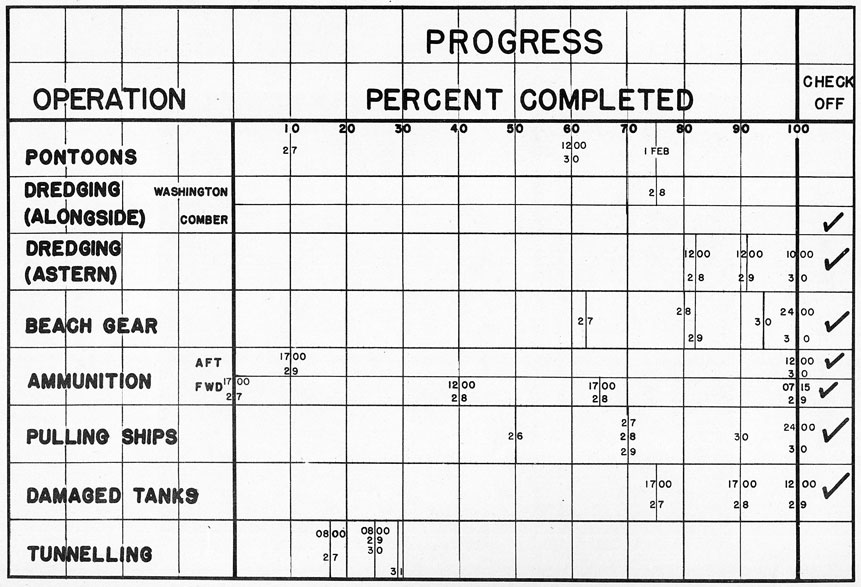
|
|
|
SUMMARY OF DAMAGE
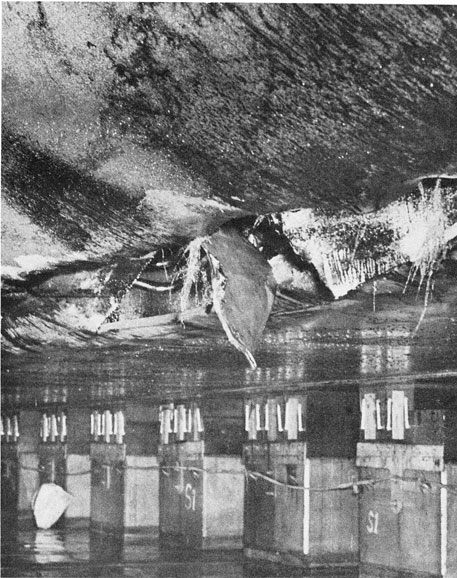
ENCLOSURE 11
|
2
|
|
SUMMARY OF DAMAGE
1. The damage to the U. S. S. MISSOURI (BB63) incurred during grounding on 17 January 1950, and during refloating operations from 17 January through 1 February 1950, falls into the following two categories:
|
a. Damage incurred as a direct result of grounding.
b. Damage incurred as a result of refloating operations subsequent to grounding.
|
2. The following damage was incurred by the vessel as a direct result of grounding:
|
a. Starboard shell plating strake G was damaged by dishing and rupture between frames 100 and 114; sharp dishing between frames 100 and 102; rupture between frames 102 and 108; and dishing between frames 108 and 114. This damage opened tanks B-29-F, B-37-F and B-43-F to the sea.
b. A number of fuel oil heating coils in way of the damage to tanks B-29-F, B-37-F, and B-43-F were bent or ruptured.
c. Two TBM motor generator armatures burned out due to lack of ventilation, because of loss of power.
d. General plugging with sand and debris of all injections and overboard discharges except for those of the after Emergency Diesel Generator Set, which set furnished power for ventilation and lighting until number 7 Main turbo generator was restored to operation.
|
3. The following damage was caused by refloating operations subsequent to grounding:
|
a. Number 2, 3 and 4 propeller blade edges suffered minor bending and cracking, from pontoon wires and chains.
b. Twenty Tank-O-Meter gages were rendered inoperative by the two explosive charges set off in the vicinity of the ship on 29 January.
c. The following machinery, which had to be used during the refloating operations, was damaged.
|
(1) Numbers 5, 6, 7 and 8 turbo generators. Casings, impeller wearing rings and lower steady bearings were scored.
(2) Number 1, 2, 3 and 4 fire and bilge pumps. Packing journals were badly scored; casing and impeller rings were scored but not badly worn.
(3) Number 5 main drain pump. Casing and impeller seal rings were badly scored.
(4) Numbers 1, 2, 3 and 4 cooling water pumps. Casing and impeller rings were badly scored.
(5) Number 5 fire and bilge pump (reciprocating). The water end was badly scored.
|
In the above pumps, tolerances were not generally too great for continued operations, how-' ever, all wearing rings were badly scored or cut due to sand passing through the pumps. Only the four cooling water pumps were removed from the ship for overhaul; only the shafts and impellers for the remaining pumps were removed from the ship for repairs. All these pumps may have suffered some minor damage during the actual grounding, however, the damage that necessitated overhaul was definitely incurred during the refloating operations.
|
|
|
|
PUBLIC RELATIONS
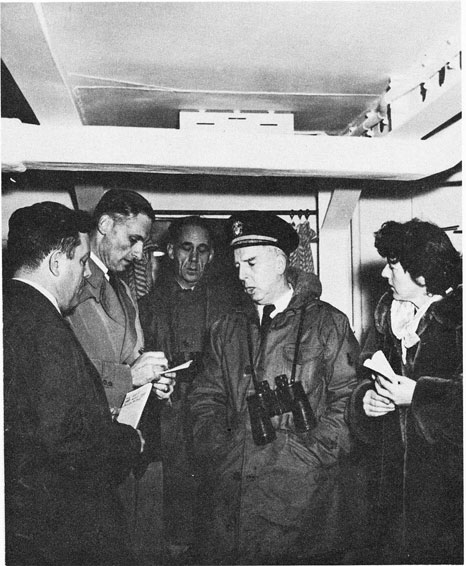
ENCLOSURE 12
|
1
|
|
PUBLIC RELATIONS
1. Because of the history of the U. S. S. MISSOURI and its unusual situation as the sole remaining battleship in commission, the grounding of that vessel on 17 January 1950, generated intense public interest. The extent of this interest and the many ramifications of the public relations problems which were to develop were not, however, immediately recognized. During the first few days following the grounding Commander Cruisers concentrated all efforts on the urgent task of commencing salvage measures, and as a result no public relations policy was formulated other than a general arrangement for the control of public information by Commander in Chief, U. S. Atlantic Fleet.
2. Mounting public interest and insistent demands by the press for information, especially after the unsuccessful pull-off attempt on 20 January, gave rise to the press conference on Monday, 23 January, which was held by the Commander in Chief, U. S. Atlantic Fleet with Commander Cruisers present. For the first time a full statement of the general situation and factors influencing the salvage effort was issued to the public. The extent of the grounding and the nature of the bottom were presented in such a way as to make clear to the press media the difficulty of the refloating operation and the fact that hope had never been held out for the success of the first attempts. At the conclusion of this presentation, Commander Cruisers invited the press to come aboard for two hours that afternoon. All the press accepted, and were given the run of the ship and any assistance needed for their stories or broadcasts.
3. This initial silence of six days with respect to official information resulted in the following misconceptions on the part of the public which were but slowly corrected.
|
a. That the ship rested on soft mud.
b. That the grounding was not nearly so extensive as the actual 12000-17000 tons.
c. That the ship departed from the main ship channel entirely through negligence. Information as to the acoustic range was purely rumor.
d. That the pull-off attempt of 20 January was a maximum effort with hope of success.
e. That the delay until 2 February was a matter of giving up and waiting, rather than a crowded period of preparation.
|
4. The press conference on 23 January marked a turning point in the public relations aspect of the grounding. Until this time the publicity had been almost wholly unfavorable to the Navy. Coming on the heels of the unification investigation it gave additional fuel to those of the press who were critical of the Navy. But with the attention turned to the magnitude and difficulty of the salvage operations and the Navy's efficiency in tackling such a task, the publicity became largely favorable. Public relations-wise the MISSOURI grounding proved to be a good example of the utilization of the favorable aspects of what is essentially an unfavorable public relations situation to arrive at a favorable end result.
5. Since the handling of press media and telephonic inquiries was necessarily done ashore at the public information offices of CinCLantFlt and FIFTH Naval District Headquarters, the largest item faced by Commander Cruisers was the processing and answering of correspondence containing suggestions for refloating the MISSOURI. Because it was felt that the best means of handling these letters and telegrams would be by a personal reply from the Officer in Command of Refloating Operations, all commands and offices which might receive such communications were invited to forward them to Commander Cruisers for reply, including those submitted by telephone. A total of 650 were finally received, and each one of these that was capable of a response was answered by a personal letter from Rear Admiral Smith. In addition 227 were answered directly by the Chief of the Bureau of Ships. Enclosed with each of the 610 replies mailed was a statement of factors affecting the refloating and a photostatic diagram of the pull-off arrangement of ships and beach gear. Because of the personal touch these letters were regarded as a most important component of the public relations aspect of the salvage operation and, therefore, each suggestion was given careful attention to avoid any suspicion of a form answer. The seriousness of the people who submitted suggestions was most impressive. Not more than six were intended to be humorous, and of these few only one was in a derogatory vein. Indicative of the world interest in the MISSOURI is the fact that these suggestions came from every state in the union plus 44 from Britain, 14 from Canada, and 1 each from France, Portugal, Italy, Cuba, Mexico, Peru, and Chile.
|
2
|
|
6. In addition to the information forwarded with these letters, the same enclosures were sent to all line flag officers of the Navy, plus key flag officers of the staff corps with the suggestion that they be used to assist in answering inquiries received locally and otherwise disseminated as seen fit. The replies received indicate that this information was utilized to good advantage in the public information offices of the various commands, especially in those of the naval districts.
7. Except for the visit during the afternoon of 23 January and for a few isolated visits, the press was not received on board the MISSOURI in large numbers until the evening prior to the pull-off attempt of 31 January, when about 55 representatives, came aboard including those of newsreels, radio stations, AP, UP and INS. The general handling of this group was controlled by the Staff Public Information Officer with the ship providing messing and berthing facilities and officer escorts. A press conference was held by Commander Cruisers late in the evening to brief the press on the final arrangements and on the general plan for the following morning.
8. Because of the change of command ceremony of the Atlantic Fleet scheduled for 0900 on 1 February, only about twelve press representatives boarded the MISSOURI the preceding evening. The remainder chose to view the pull-off from boats and came on board after the ship had been successfully moved to deep water. A short press conference was held at this point just prior to the departure of all the press representatives to file their stories. A continuous shuttle of motor torpedo boats provided ample transportation and avoided any possibility of complaints of favoritism with respect to deadlines. A final press conference was held at 1500 on that day after the MISSOURI had been placed in the Naval Shipyard drydock, when the entire operation was reviewed. Among the many and several written compliments for the overall excellence of press relations it is significant that only a single complaint was registered, and this proved upon investigation to be ill-founded.
9. Although the refloating resulted in a desirable decrease in newspaper coverage, the public relations aspect of the operation was far from ended. It continued with newspaper feature articles and with an interview of Commander Cruisers on the radio program "We the People" conducted by the National Broadcasting Company on 3 February. As late as 3 March a representative of the Philadelphia Bulletin visited Norfolk to obtain material for a Sunday feature article and a Richmond paper made a similar request by telephone.
10. With the changed concept of public relations now in vogue, the informational aspect of the U. S. S. MISSOURI is one which cannot be neglected in staff planning. While the tendency will be at the time to regard it as an unnecessary burden on those charged with the conduct of the actual operation, the long range effects may well prove to be of more importance than the incident itself.
|
|
|